
从Oracle 10g开始,甲骨文公司新增了XQuery和XMLTable两个功能作为处理XML的武器。 XMLQuery一样,您可以使用XQuery语言构造XML数据和查询XML和关系数据。你可以使用XMLTable从XQuery查询结果创建关系表和列。

本文我们将了解Oracle XMLTable函数,并且通过例子介绍XMLTable函数的用法。
考虑到员工会有一些XML数据,所以我们创建一个EMPLOYEES表:
Create TABLE EMPLOYEES
(
id NUMBER,
data XMLTYPE
)
表创建完成后,我们往表里插入一些数据:
SQL Code
1 | Insert INTO EMPLOYEES |
注意:XML包含了员工的相关数据,在我们开始学习之前我们首先明确几个数据:
1、有4名员工在我们的XML文件
2、每个员工都有通过属性定义一个唯一的员工id emplid
3、每个员工也有一个属性type,定义雇员是否是管理员或用户。
4、每个员工都有四个子节点: firstname , lastname , age和email
5、年龄是多少
现在我们可以使用Oracle XMLTable函数从XML中检索不同的信息。
1、学习XPath表达式
使用XMLTable函数之前最好知道一点关于XPath。XPath使用路径表达式来选择XML文档中的节点或节点列表。看下面的列表:
Expression | Description |
nodename | 选择所有名称为"nodename"的节点 |
/ | 选择根节点 |
// | 从当前节点选择文档中相匹配的节点,无论他们在哪里 |
. | 选择当前节点 |
.. | 选择当前节点的父节点 |
@ | 选择属性 |
employee | 选择所有名称为"employee"的节点 |
employees/employee | 选择所有子节点为employee的employees节点 |
//employee | 选择所有employee的元素,无论他们在哪里 |
下面的表达式称为谓词列表。谓词在方括号中定义 [ ... ]。他们被用来找到一个特定的节点或包含一个特定值的节点。
Path Expression | Result |
/employees/employee[1] | 选择第一个employee节点,它是employees的子节点。 |
/employees/employee[last()] | 选择最后一个employee元素,它是employees的子节点 |
/employees/employee[last()-1] | 选择是employees子元素的倒数第二个employee元素 |
//employee[@type='admin'] | 选择所有具有与'admin'的值的属性命名类型的employee元素 |
其他更多的表达式可以参考Oracle官方手册
2、Oracle XMLTable函数的基础知识
读取Employees中所有firstname和lastname
在这个查询中,我们使用XMLTable函数从EMPLOYEES表解析XML内容。
select t.id, x.*
from employees t,
xmltable('/Employees/Employee' passing t.data columns firstname
varchar2(30) path 'firstname',
lastname varchar2(30) path 'lastname') x
where t.id = 1;
注XMLTable函数的语法:
XMLTable('<XQuery>'
PASSING <xml column>
COLUMNS <new column name> <column type> PATH <XQuery path>)
XMLTABLE函数包含一个XQuery行表达式和由一个或多个列表达式组成的COLUMNS子句。在上面的语句中,行表达式是 XPath /Employees/Employee。PASSING子句中的t.data指的是employees表中的XML列中的数据。
COLUMNS 子句用于将XML数据转换成关系数据,这里每个参数都定义了一个列名和SQL数据类型。在上面的查询中,我们定义了firstname 和 lastname列并指向PATH的firstname 和 lastname或者选定的节点。
输出:
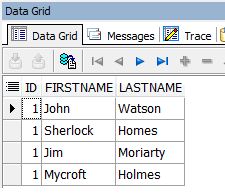
使用text()读取节点值
在上面的教程中,我们读取到了firstname / lastname节点。通常我们还需要获取节点的文本值,下面的例子中,我们选取/Employees/Employee/firstname路径,并使用text()获取节点的值。
下面查询employees中所有的firstname
select t.id, x.*
from employees t,
xmltable('/Employees/Employee/firstname' passing t.data columns
firstname varchar2(30) path 'text()') x
where t.id = 1
输出:
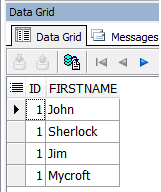
不仅仅是text()表达式,Oracle还提供了其他很多有用的表达式,如 item(), node(), attribute(), element(), document-node(), namespace(), text(), xs:integer, xs:string。
读取所选节点的属性
XML节点定了相关属性,我们也可以读取到节点的这些属性,下面的查询是找出employee节点的type属性:
select emp.id, x.*
from employees emp,
xmltable('/Employees/Employee' passing emp.data columns firstname
varchar2(30) path 'firstname',
type varchar2(30) path '@type') x;
输出:

使用ID读取特定的记录
select t.id, x.*
from employees t,
xmltable('/Employees/Employee[@emplid=2222]' passing t.data columns
firstname varchar2(30) path 'firstname',
lastname varchar2(30) path 'lastname') x
where t.id = 1;
输出:
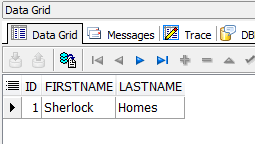
读取所有类型是admin的员工的firstname 和 lastname
select t.id, x.*
from employees t,
xmltable('/Employees/Employee[@type="admin"]' passing t.data columns
firstname varchar2(30) path 'firstname',
lastname varchar2(30) path 'lastname') x
where t.id = 1;
输出:
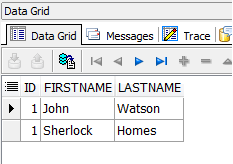
读取年龄超过40的所有员工的firstname 和 lastname
select t.id, x.*
from employees t,
xmltable('/Employees/Employee[age>40]' passing t.data columns
firstname varchar2(30) path 'firstname',
lastname varchar2(30) path 'lastname',
age varchar2(30) path 'age') x
where t.id = 1;
输出:
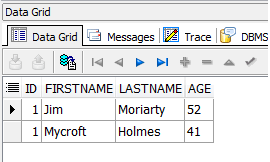
本文由UncleToo翻译整理,转载请注明出处!
原文(英文)地址:http://viralpatel.net/blogs/oracle-xmltable-tutorial/